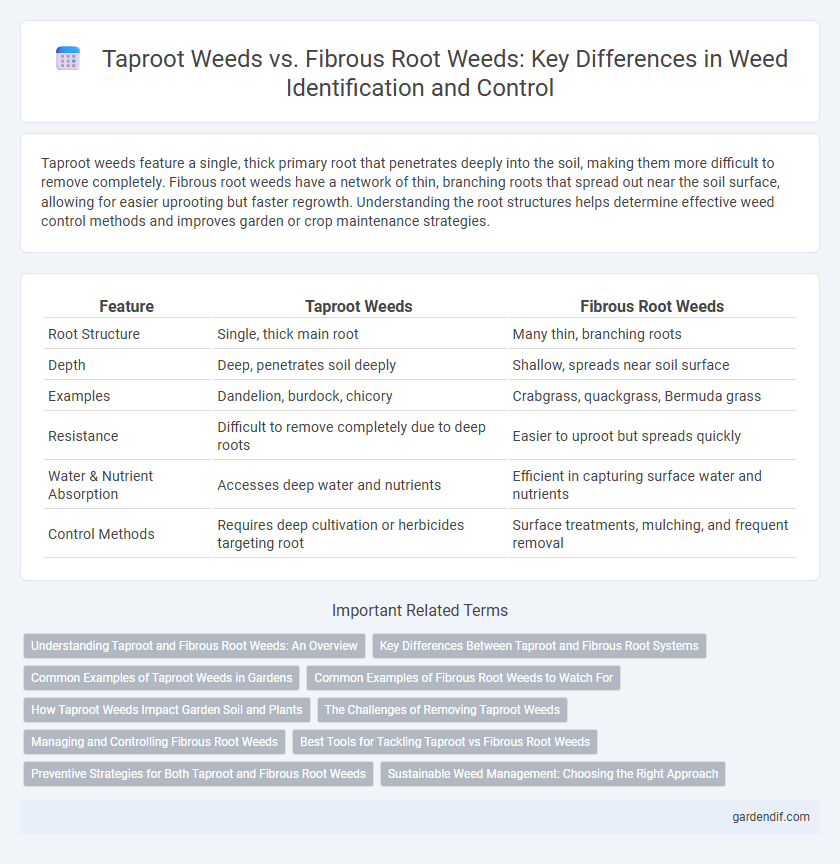
Taproot weeds vs fibrous root weeds Illustration
Taproot weeds feature a single, thick primary root that penetrates deeply into the soil, making them more difficult to remove completely. Fibrous root weeds have a network of thin, branching roots that spread out near the soil surface, allowing for easier uprooting but faster regrowth. Understanding the root structures helps determine effective weed control methods and improves garden or crop maintenance strategies.
Table of Comparison
| Feature | Taproot Weeds | Fibrous Root Weeds |
|---|---|---|
| Root Structure | Single, thick main root | Many thin, branching roots |
| Depth | Deep, penetrates soil deeply | Shallow, spreads near soil surface |
| Examples | Dandelion, burdock, chicory | Crabgrass, quackgrass, Bermuda grass |
| Resistance | Difficult to remove completely due to deep roots | Easier to uproot but spreads quickly |
| Water & Nutrient Absorption | Accesses deep water and nutrients | Efficient in capturing surface water and nutrients |
| Control Methods | Requires deep cultivation or herbicides targeting root | Surface treatments, mulching, and frequent removal |
Understanding Taproot and Fibrous Root Weeds: An Overview
Taproot weeds possess a central, dominant root that penetrates deeply into the soil, enabling efficient nutrient and water absorption, which makes them resilient to drought and disturbance. Fibrous root weeds feature a dense network of thin roots spreading near the soil surface, allowing rapid nutrient uptake and quick soil stabilization. Understanding the differences between taproot and fibrous root weed systems is crucial for selecting appropriate weed management and control strategies in agriculture and gardening.
Key Differences Between Taproot and Fibrous Root Systems
Taproot weeds develop a single, thick primary root that grows deep into the soil, allowing access to nutrients and water from lower soil layers, while fibrous root weeds consist of numerous thin, branching roots spreading near the soil surface, enhancing soil erosion prevention and nutrient uptake in topsoil. Taproot systems offer greater anchorage and drought resistance compared to fibrous roots, which excel in rapid nutrient absorption and surface soil stabilization. Understanding these key differences aids in targeted weed management strategies, such as selective herbicide application and mechanical removal based on root system type.
Common Examples of Taproot Weeds in Gardens
Common examples of taproot weeds in gardens include dandelions, burdock, and chicory, all characterized by deep, central roots that anchor the plant firmly and make removal challenging. These taproot weeds store nutrients in their thick roots, allowing them to survive harsh conditions and regrow after cutting. Effective management often requires extracting the entire root system to prevent rapid regrowth and spread in garden beds.
Common Examples of Fibrous Root Weeds to Watch For
Common examples of fibrous root weeds to watch for include crabgrass, barnyardgrass, and nutsedge, which thrive in lawns and gardens by spreading rapidly through dense, fibrous root systems. These weeds are difficult to control due to their ability to regenerate from root fragments and their resilience in compacted soils. Effective management requires targeted herbicides and cultural practices that disrupt the fibrous roots and prevent re-establishment.
How Taproot Weeds Impact Garden Soil and Plants
Taproot weeds penetrate deeply into garden soil, disrupting soil structure and competing directly with plants for water and nutrients at lower soil levels. Their extensive root systems can cause soil compaction, reducing aeration and hindering root growth of desirable plants. Managing taproot weeds is crucial because their removal often requires digging, which can disturb surrounding plants and soil ecosystems.
The Challenges of Removing Taproot Weeds
Taproot weeds present significant challenges in removal due to their deep, central root system that anchors the plant firmly in the soil, making manual extraction difficult without breaking the root. Unlike fibrous root weeds, which have shallow, widespread roots that can be pulled out more easily, taproot weeds such as dandelions and thistles often regrow from any remaining root fragments. Effective management of taproot weeds requires persistent digging and the use of targeted herbicides to prevent regrowth and protect crop health.
Managing and Controlling Fibrous Root Weeds
Managing fibrous root weeds requires targeted strategies due to their dense, shallow root systems that spread extensively through soil layers. Effective control involves using herbicides designed for surface applications, alongside mechanical methods like shallow cultivation to disrupt root mats without harming crops. Consistent monitoring and integrated weed management practices reduce fibrous root weed persistence, improving overall crop health and yield.
Best Tools for Tackling Taproot vs Fibrous Root Weeds
Effective removal of taproot weeds like dandelions requires deep-rooted tools such as long-handled weed pullers or specialized dandelion forks that can extract the entire root system to prevent regrowth. For fibrous root weeds, a hoe or garden cultivator is ideal for severing the shallow, dense root mats that spread near the soil surface, enabling easy disruption and removal. Combining these targeted tools with consistent weeding practices ensures better control of both taproot and fibrous root weed infestations in gardens and landscapes.
Preventive Strategies for Both Taproot and Fibrous Root Weeds
Effective preventive strategies for taproot and fibrous root weeds involve maintaining healthy soil through regular mulching and proper irrigation, which inhibits weed seed germination. Implementing crop rotation disrupts weed life cycles by varying root structures and nutrient uptake, reducing weed establishment. Frequent monitoring and early mechanical removal target young weeds before root systems become extensive, minimizing long-term weed persistence.
Sustainable Weed Management: Choosing the Right Approach
Taproot weeds penetrate deep into the soil, making mechanical removal more challenging but effective for long-term soil health, while fibrous root weeds spread superficially and grow rapidly, requiring frequent management to prevent soil erosion. Sustainable weed management emphasizes integrating biological controls, mulching, and targeted herbicide use tailored to root type to minimize chemical impact and promote ecosystem balance. Choosing the right approach depends on accurate weed identification and understanding root architecture, ensuring optimized resource use and reduced environmental footprint.
Taproot weeds vs fibrous root weeds Infographic

 gardendif.com
gardendif.com